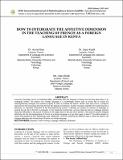| dc.contributor.author | Auma Rose, Joyce Kasili, Ms Clara Bulili | |
| dc.date.accessioned | 2020-11-24T13:25:49Z | |
| dc.date.available | 2020-11-24T13:25:49Z | |
| dc.date.issued | 2020-08-08 | |
| dc.identifier.uri | https://repository.maseno.ac.ke/handle/123456789/2988 | |
| dc.description.abstract | Learning a language can be a complicated affair, particularly when the language is foreign and learning takes place in an
exolingual context. The teacher of a foreign language in a multilingual context such as Kenya has to choose his
teaching/learning strategies and activities properly in order to motivate the learner. He/she must also ensure a conducive
environment that encourages learning through his attitude and behavior. Another necessary ingredient for achieving this is
affectivity, an important component of the teaching/learning process. Following our practice as teachers of languages in
general and of that of French in particular, in the mentioned environment, we have observed that our colleague teachers
encounter difficulties in the pursuit of interest in the subject area on the part of the learners. How does the teacher integrate
affectivity into the learning/teaching of French as a foreign language as to get them eager to learn? This article attempts to
answer this question by first, defining the term “affectivity,” and then exploring the different ways in which the teacher can
integrate affectivity into the teaching of French as a foreign language. | en_US |
| dc.subject | Didactics, French Foreign Language, Affectivity, Motivation | en_US |
| dc.title | HOW TO INTERGRATE THE AFFECTIVE DIMENSION IN THE TEACHING OF FRENCH AS A FOREIGN LANGUAGE IN KENYA | en_US |
| dc.type | Article | en_US |

